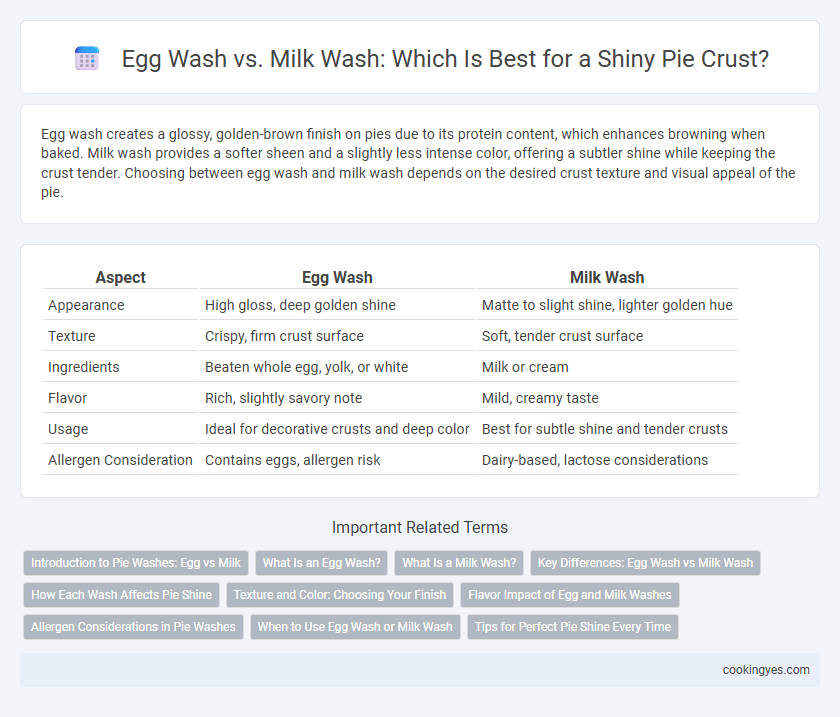Egg wash creates a glossy, golden-brown finish on pies due to its protein content, which enhances browning when baked. Milk wash provides a softer sheen and a slightly less intense color, offering a subtler shine while keeping the crust tender. Choosing between egg wash and milk wash depends on the desired crust texture and visual appeal of the pie.
Table of Comparison
| Aspect | Egg Wash | Milk Wash |
|---|---|---|
| Appearance | High gloss, deep golden shine | Matte to slight shine, lighter golden hue |
| Texture | Crispy, firm crust surface | Soft, tender crust surface |
| Ingredients | Beaten whole egg, yolk, or white | Milk or cream |
| Flavor | Rich, slightly savory note | Mild, creamy taste |
| Usage | Ideal for decorative crusts and deep color | Best for subtle shine and tender crusts |
| Allergen Consideration | Contains eggs, allergen risk | Dairy-based, lactose considerations |
Introduction to Pie Washes: Egg vs Milk
Egg wash and milk wash are two common methods used to achieve a glossy, golden finish on pie crusts during baking. Egg wash, made from beaten eggs sometimes mixed with water or milk, creates a rich, shiny surface with a deeper golden color, enhancing the pie's visual appeal. Milk wash provides a softer sheen and a slightly lighter crust color, ideal for delicate pastries that require subtle browning without overpowering shine.
What Is an Egg Wash?
An egg wash, typically made from beaten eggs mixed with water or milk, creates a glossy, golden-brown finish on pie crusts by promoting browning during baking. Its proteins coagulate and sugars caramelize, resulting in a more vibrant and appealing shine compared to milk wash alone. Using an egg wash enhances crust texture and color, making pies visually enticing and professional-looking.
What Is a Milk Wash?
A milk wash, commonly used in pie baking, involves brushing the crust with milk before baking to achieve a glossy, golden finish. The proteins and sugars in milk caramelize during baking, enhancing the pie's color and creating a subtle sheen. Unlike an egg wash, milk wash produces a lighter shine without the added richness or browning intensity.
Key Differences: Egg Wash vs Milk Wash
Egg wash, made from beaten eggs and sometimes water or milk, creates a glossy, golden-brown finish on pies by enhancing Maillard reaction during baking. Milk wash, typically whole or skim milk brushed on pie crusts, provides a softer shine with a lighter, less intense browning effect compared to egg wash. Egg wash offers a more pronounced shine and color contrast, while milk wash is preferred for a subtle, matte finish and improved crust tenderness.
How Each Wash Affects Pie Shine
Egg wash creates a rich, golden shine on pies due to its protein and fat content, which caramelizes during baking for a glossy, appetizing finish. Milk wash provides a softer, more subtle sheen with a slight browning effect caused by lactose sugars, resulting in a matte, tender crust appearance. The choice between egg wash and milk wash directly influences the pie's surface texture and visual appeal, with egg wash offering a more vibrant gloss compared to milk's muted shine.
Texture and Color: Choosing Your Finish
Egg wash creates a glossy, deep golden-brown finish on pie crusts, producing a rich texture with a slight crispness. Milk wash offers a softer, matte sheen with a lighter color, resulting in a tender, less crunchy crust. Selecting between egg wash and milk wash depends on desired pie texture and visual appeal, with egg wash favored for a bold shine and milk wash for a subtle glow.
Flavor Impact of Egg and Milk Washes
Egg wash enhances pie shine with a rich, savory flavor due to its protein and fat content, creating a golden, slightly crispy crust. Milk wash offers a milder, creamier taste that subtly sweetens the crust while providing a softer, less glossy finish. Choosing between egg and milk wash influences not only the pie's appearance but also the depth and warmth of its flavor profile.
Allergen Considerations in Pie Washes
Egg wash, containing proteins like albumin and potential traces of egg allergens, poses a risk to individuals with egg allergies, whereas milk wash includes lactose and milk proteins such as casein and whey that may trigger reactions in those with dairy allergies. Choosing between egg wash and milk wash requires careful consideration of the pie consumers' allergen sensitivities to prevent cross-contamination and allergic responses. Using allergen-free alternatives like oil or water-based washes can enhance pie shine without exposing sensitive individuals to egg or milk allergens.
When to Use Egg Wash or Milk Wash
Egg wash is ideal for pies that require a rich, golden-brown finish, especially fruit pies and hand pies, as it enhances color and adds a glossy sheen. Milk wash works best for pies where a softer, matte crust is preferred, such as cream or custard pies, providing gentle browning without overpowering the delicate flavors. Choosing between egg wash and milk wash depends on the desired crust texture and visual appeal specific to the pie type.
Tips for Perfect Pie Shine Every Time
For perfect pie shine every time, use egg wash composed of one beaten egg mixed with a tablespoon of water or milk, which provides a rich golden color and a glossy finish. Milk wash offers a lighter shine and softer crust, ideal for less intense browning or for delicate pastries. Applying the wash with a soft brush evenly before baking ensures consistent shine and prevents soggy spots on your pie crust.
Egg Wash vs Milk Wash for Pie Shine Infographic

 cookingyes.com
cookingyes.com